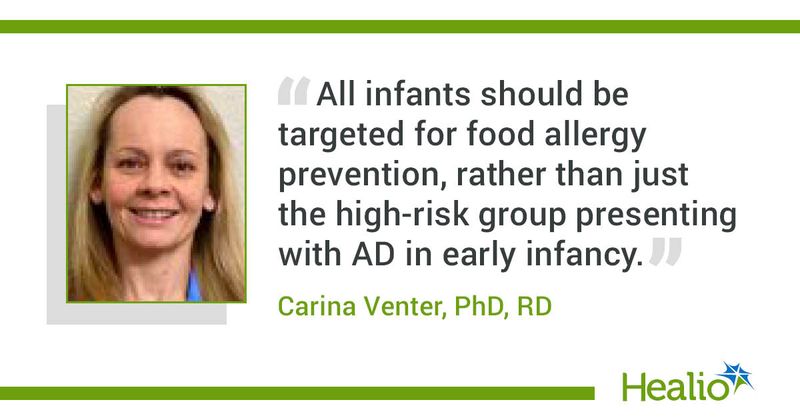Food allergy may be bidirectionally associated with atopic dermatitis
Click Here to Manage Email Alerts
Key takeaways:
- By age 4 years, children with atopic dermatitis were five times more likely to develop a food allergy.
- Children with food allergy were eight times more likely to develop atopic dermatitis by age 1 year.
Children diagnosed with atopic dermatitis or food allergy were more likely to develop either disorder as time went on, according to a study published in Pediatric Allergy and Immunology.
“Atopic dermatitis (AD) is considered to occur before the development of food allergy (FA),” Carina Venter, PhD, RD, associate professor of pediatrics at the University of Colorado Denver School of Medicine, Children’s Hospital Colorado, told Healio.

“We wanted to study if there are other directions these two diseases occur as well. We conducted a descriptive analysis of transitions between no disease (ie, no FA and no AD), FA but not AD, AD but not FA, or both FA and AD,” continued Venter, who also is chair of the European Academy of Allergy and Clinical Immunology Work Group on Immunomodulation and Nutrition.
The study recruited pregnant women aged at least 16 years from obstetrics clinics between 2009 and 2014. The women were given questionnaires on their medical history and asked to give consent for the review of their children’s medical records for up to 4 years.
Researchers studied the transitions between disease status in early infancy as well as two critical time periods in FA and AD development. The time periods included up to 12 months of age and up to 4 years of age.
“The majority of children develop AD in the first year of life, and most children develop food allergy before 5 years of age,” Venter said.
In total, medical records were obtained from 1,261 children (47.7% girls; 50% white) to determine the onset of FA and AD. Among the 1,261 children, 1,157 had neither AD or FA, 107 had AD, two had FA and one had both AD and FA.
By age 6 months, children with AD but not FA were 7.8 times (95% CI, 2.5-24.3) more likely to be diagnosed with FA by age 1 year compared with those with no disease, whereas children with FA but not AD were 8.3 times (95% CI, 2-33.9) more likely to face an AD diagnosis.
Those with AD but not FA by age 6 months were also 5.3 times (95% CI, 2.8-10.3) more likely to be diagnosed with FA by age 4 years vs. children with no disease. Children with FA but not AD were 5.3 times (95% CI, 2.4-11.95) more likely to have an AD diagnosis by age 4 years.
“It is important to understand that not all food allergy is preceded by AD,” Venter said. “This has implications for food allergy prevention, ie, all infants should be targeted for food allergy prevention, rather than just the high-risk group presenting with AD in early infancy.”
She further explained that in future studies, the data need to be replicated in larger cohorts with clearly defined disease outcomes.
“Disease outcomes should be studied as they occur rather than based on retrospective questionnaire data,” Venter said.
